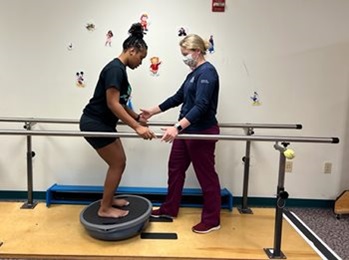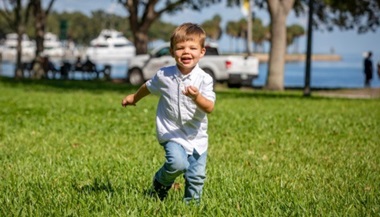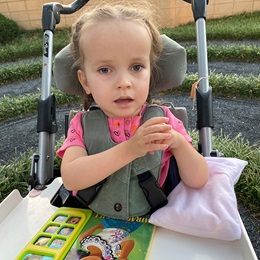Patient Story
Pediatric Epilepsy Surgery: Bailey’s Story
Patient Story Highlights
- Bailey was 11 years old when she was diagnosed with epilepsy, causing seizures.
- Bailey’s condition was difficult to treat. She tried several medications, and her condition impacted things like schooling and her ability to get a learner’s permit.
- She was referred to the Epilepsy and Seizure Management Center at Johns Hopkins All Children’s Hospital, where doctors recommended lesionectomy, a type of brain surgery, which has eliminated her seizures.

Eighteen-year-old Bailey’s mom, Jennifer, remembers the day when she first realized something might be seriously wrong with her daughter.
The family was enjoying an outing to a fall festival in their hometown of Lakeland, Florida. It was a late afternoon, filled with all the sights and sounds of a community carnival — fast-moving rides, colorful blinking lights, the smells of fair food wafting through the air and the squeals of happy children.
Bailey, who was 11 at the time, and her big sister Savannah were high in the air on a Ferris wheel ride as their parents looked on.
But something wasn’t right.
Bailey had a strange look on her face. She had a blank stare. Was she about to get sick on the ride?
“She was just out of it,” Jennifer says. “When she got off the ride, she seemed to have no awareness of what was happening around her. It was really concerning.”
As it turned out, there was good reason for concern. Bailey was having an epileptic seizure.
“I remembered absolutely nothing,” Bailey says.
Diagnosed With Epilepsy
Jennifer promptly took Bailey to her pediatrician, then to a neurologist and, in 2017, she was diagnosed with epilepsy.
Seizures don’t always come with the body seizing up and jerking or twisting, as is classically portrayed in films. There are many types of seizures. Bailey’s were more subtle to the eye, but just as potentially dangerous.
Her complex focal aware seizures would begin with an aura, or disturbance in vision. She would then lose awareness and stop whatever activity she was engaged in. Sometimes she would make involuntary noises. After the seizure, she would not be able to recall what happened to her.
“Any type of seizure can be dangerous and needs appropriate treatment,” says Neel Parikh, M.D., a pediatric neurologist with Johns Hopkins All Children’s Hospital in St. Petersburg, Florida. “Seizures can become progressively worse and create more and more scar tissue, damaging the brain. They can lead to injuries, to the loss of independence. They certainly impact quality of life.”
But answers did not come easily for Bailey. The ensuing years would be filled with doctor visits and medication after medication to try to control her epilepsy. A drug would seem to help for a while, then the seizures would return.
As Bailey grew into a teenager, her condition was making it hard for her to live the life her peers were enjoying.
“It was a constant state of fear,” Jennifer says. “Something as simple as Bailey wanting to go to the beach with a friend. We were frantic, like ‘No, I don’t think so.’ It was always a case of ‘What if? What if?’”
Bailey’s seizures kept her from getting a driver’s permit when she turned 15.
They also impacted her grades. She was always concerned that she would have a seizure in class.
“One girl said to me, ‘Oh, yeah, you were making noises.’ I was like, ‘That’s embarrassing. Thank you for telling me,’” Bailey recalls.
Bailey’s father, Greg, worried about the way her memory could be impacted by her seizures.
“I was always afraid she would forget where she was and walk off,” Greg says. “It was scary.”
If drugs didn’t work for Bailey, then what would? One of her doctors recognized that Bailey needed an elevated level of care to treat her drug-resistant seizures. She was referred to the Epilepsy and Seizure Management Center at Johns Hopkins All Children’s Hospital.
The hospital’s Institute for Brain Protection Sciences was ranked one of the top 50 children’s hospitals for 2023-2024 by U.S. News and World Report in the specialties of pediatric neurology and neurosurgery. The institute’s Epilepsy and Seizure Management Center has a Level 4 rating by the National Association of Epilepsy Centers (NAEC).
A Level 4 rating recognizes the highest level of care to include a full range of specialists, state-of-the-art diagnostics, and the resources and expertise to provide both surgical and non-surgical interventions to the most medically complex patients.
Bailey and her family were ready for answers. After undergoing a full battery of tests and scans, doctors found the culprit. They identified a lesion buried deep inside her brain. As small as a blueberry, it was the likely cause of her seizures.
“The MRI showed structural abnormality in the middle of her brain, in the back, near the left occipital lobe,” says Matthew Smyth, M.D., chief of the Pediatric Neurosurgery Division at Johns Hopkins All Children’s. “We offered to remove the abnormal area to try and eliminate her seizures.”
Brain surgery?
It sounded so extreme.
Bailey and her family knew they had a big decision to make.
But Bailey had had enough of being ruled by her seizures. She wanted to live life fully.
Brain Surgery
In the summer after her junior year, Bailey had a lesionectomy, performed by Smyth, who has more than 20 years’ experience, and has conducted around 1,000 epilepsy surgeries in his career.
Smyth and the neurosurgical team carefully cut away a small piece of Bailey’s skull to gain access to the lesion buried deep between her occipital lobes. Using a specialized digital navigation system, they located the precise area of the abnormality and successfully removed it. The lesion would later prove to be a small non-malignant tumor, possibly something Bailey was born with.
“The whole team, everybody we came in contact with, was just amazing,” Jennifer says.
Bailey was in the hospital for two days. Then it was time to go home and heal — and to see what would happen next.
Success
Nothing happened next.
And that was the best news for Bailey. As the weeks and months have ticked by, she has had no more seizures. Her life has changed in the best ways.
Bailey got her learner’s permit to drive. She had an amazing senior year, graduating in the top 15 percent of her class. She embraces hobbies and doing things young people do, such as enjoying concerts and taking small trips with friends.
“Ever since the surgery, she has been awesome,” Jennifer says. “Her focus is back, and she seems like a different person. We’re just so grateful.”
Smyth says of the 1% of the population who have epilepsy, two-thirds have seizures that can be controlled by medication. But for the remaining one-third, there may be other promising options to consider. For many, surgery can be the answer.
“That’s why I’m here,” Smyth says. “If you can render somebody seizure-free, that is extremely meaningful. It’s just an amazing improvement in their life.”
Now Bailey can look to her future with joy and confidence.
“I have no worries. I’m just able to enjoy my life,” Bailey says. “I feel very free.”
Epilepsy and Seizure Management at Johns Hopkins All Children's
Families with children who have difficult-to-treat epilepsy or hard-to-control seizures can turn to neurologists who specialize in the treatment of epilepsy at Johns Hopkins All Children's Hospital in St. Petersburg, Florida.




